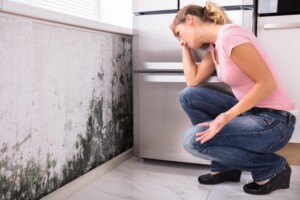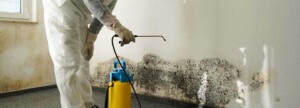 Mould inside a building can cause serious health problems, especially the toxic variety known as black mould. At Airsafe, we had a client who unfortunately left long-term mould issues untreated, resulting in a very serious illness.
Mould inside a building can cause serious health problems, especially the toxic variety known as black mould. At Airsafe, we had a client who unfortunately left long-term mould issues untreated, resulting in a very serious illness.
If you suspect you have mould in your home or workplace, get Airsafe involved, sooner rather than later.
What is black mould?
Stachybotrys chartarum, also known as black mould or toxic black mould, is a type of mould often found in damp or water-damaged buildings.
To grow, black mould needs very high moisture levels. These can be the result of flooding, leaking roofs, plumbing issues, or poor building maintenance. Black mould typically grows in materials like timber, plasterboard, wood framing, composite wood flooring, carpets, and carpet underlay.
How to identify black mould
The best way to identify black mould is by its smell and colour. Black mould has a mildewy or musty smell. True to its name, it’s distinctively black, whereas other mould species that grow in the house may be pink, grey, white or brown.

Black mould and your health
A number of symptoms can come from exposure to black mould, including:
- throat irritation
- eye irritation
- nasal and sinus congestion
- sneezing
- cough
- difficulty breathing
- chest tightness
- skin irritation.
Exposure to black mould may also cause heightened sensitivity, depending on the time and nature of exposure.
Black mould spores and associated toxins mainly cause harm via inhalation, ingestion, and contact. They can be spread through air, food, bedding or water, especially flood water.
The biggest health risks come from unusually high quantities and prolonged exposure. The condition known as sick building syndrome is often associated with black mould exposure.
At Airsafe, we know the risks of toxic mould
An example from Airsafe’s work shows what can happen if mould is left to grow.
One of our senior occupational hygienists inspected a house in Sydney’s affluent eastern suburbs to investigate a serious mould issue.
An unfixable broken water pipe under the house was causing high levels of moisture around the walls and floor surfaces. This was providing fertile ground for mould to grow, even though no water leaks were ever identified inside the house.
An occupant of the house had been experiencing allergies and skin conditions She eventually had to leave the house, and sadly has now been diagnosed with aspergillosis, a terminal illness associated with the mould in her house.
Toxic mould can be invisible and airborne. If anyone in your household or workplace suffers from asthma, a compromised immune system, breathing difficulties, or allergies, they are at risk of serious or fatal health problems if they are exposed to black mould over time.
How we assess buildings for mould
If you have any concerns about mould, the first step is to engage Airsafe for an assessment.
We begin with an inspection of the indoor environment. We survey the area for odours indicating mould or bacterial growth, moisture sources such as stagnant water or leaking pipes, and water-damaged building materials.
Air sampling is the most common way in which we assess mould levels, as it’s considered the most reliable way of assessing respiratory exposure to mould.
We sample both indoor and outdoor air comparing mould spore concentrations. If the indoor concentration is higher, or the mould is of different species, this can indicate an indoor hazard.
Where we suspect mould on a specific indoor surface, we conduct surface sampling. Surface sampling can also be used to identify the source of mould exposure.

How we solve a mould problem
Once we’ve identified a mould problem, we set about solving it.
Items that are beyond repair will require disposal. These might include porous items like mattresses, pillows, timber or plasterboard which may have absorbed quantities of mould and contaminated water.
Once the source of contamination has been found and stopped, drying will be required. This is important to prevent the mould from spreading more throughout the building. While drying is completed, it’s important avoid disturbing the mould spores and dust, which might cause them to re-enter the air inside the building.
With all the surfaces dried out, remaining items within the building will need cleaning with a damp wipe or A HEPA vacuum.
If mould spores have gotten into the air ducts and vents, they can circulate around the building inadvertently, so these areas need to be thoroughly cleaned as well.
Once all these actions have been taken, we complete a visual inspection and repeat air or surface sampling as required. New samples are sent to a laboratory for analysis before a clearance certificate is issued.
Concerned about mould? Call Airsafe on (02) 9555 9034 for an urgent assessment.



